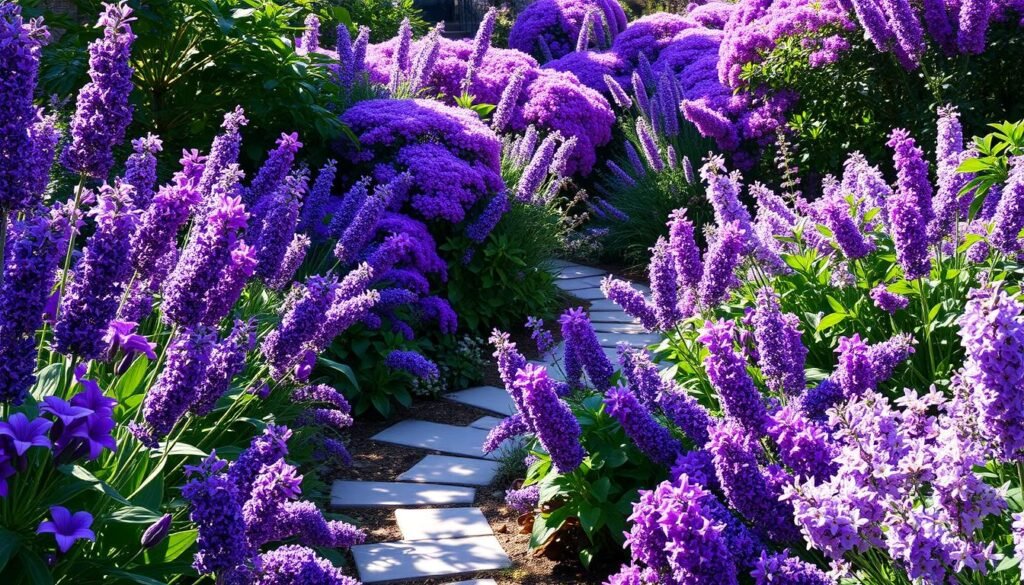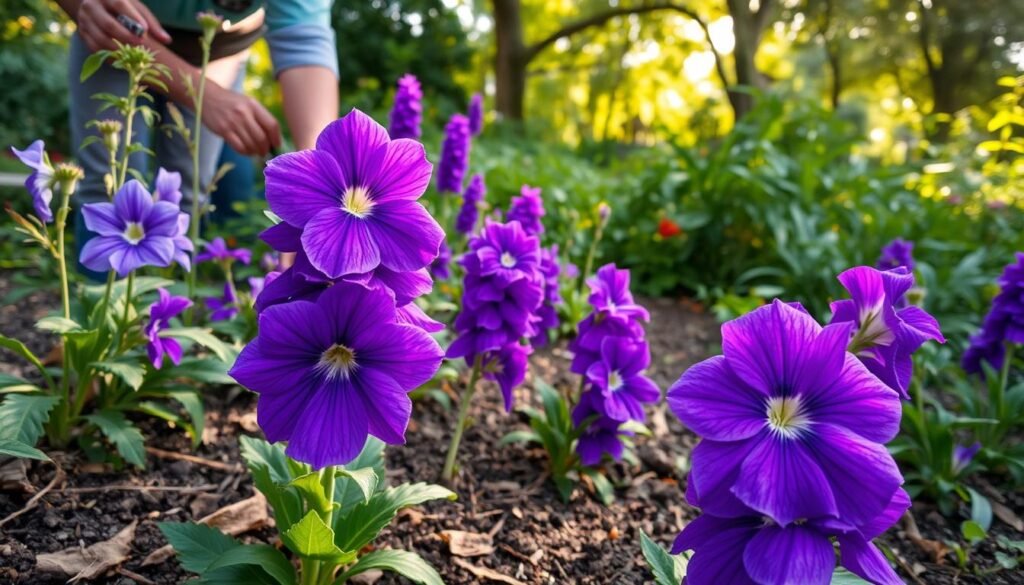Stunning Purple Flowers for Your Garden
Purple flowers make gardens look amazing with their beauty and charm. They give gardeners a wide range of colors to work with. From soft lavender to deep purple, they add beauty to any garden.
People love purple flowers for their ability to make gardens stand out. They can be used in borders, containers, or mixed beds. These flowers create beautiful scenes that grab everyone's attention.
Purple flowers are not just pretty; they also attract butterflies and bees. They come in a variety of shades, from light lavender to deep purple. This lets gardeners create unique and interesting designs that show off their style.
Table of Contents
Key Takeaways
- Purple flowers offer exceptional visual diversity in garden design
- Wide range of purple bloom varieties available for different landscapes
- Attracts beneficial pollinators to garden spaces
- Creates sophisticated and dynamic outdoor environments
- Suitable for multiple gardening styles and preferences
Understanding the Appeal of Purple Flowers in Garden Design
Purple flowers add magic to garden design, offering more than beauty. They tap into deep emotions, changing outdoor spaces with their rich colors.
Color psychology shows purple's amazing effect on emotions. Purple flowers bring luxury, creativity, and calm, making them key in garden design.
Emotional Landscape of Purple
- Creates a sense of calm and relaxation
- Stimulates creativity and imagination
- Represents sophistication and elegance
Visual Depth and Composition
Purple flowers add depth to gardens. They create layers, guiding the eye through spaces and adding interest.
| Purple Flower Type | Visual Impact | Mood Effect |
|---|---|---|
| Lavender | Soft Layering | Calming |
| Iris | Dramatic Focal Point | Regal |
| Clematis | Vertical Depth | Inspiring |
"Purple speaks of nobility, wisdom, and transformation in garden design." - Garden Design Quarterly
Gardeners can create spaces that touch the heart by understanding color and design. Purple flowers bring a sophisticated touch, making gardens inspiring and calming.
Best Growing Conditions for Purple Blooming Plants
To get the best out of purple flowers, you need to know what they like. Gardeners can make their plants bloom beautifully by focusing on a few key things.
There are a few important things to consider for purple flowers to grow well:
- Soil requirements that match specific plant needs
- Optimal sunlight exposure
- Proper drainage and moisture management
- Appropriate temperature ranges
Each purple flower has its own soil needs. Some love rich, loamy soil, while others do better in sandy or well-draining soil. Lavender, for example, needs alkaline soil that drains well.
"The secret to beautiful purple flowers is understanding their specific environmental preferences." - Garden Expert
| Purple Flower Type | Soil pH | Sunlight Needs | Moisture Level |
|---|---|---|---|
| Lavender | 6.7-7.3 | Full sun | Low |
| Iris | 6.0-7.0 | Partial to full sun | Medium |
| Clematis | 5.5-6.5 | Partial shade | Consistent |
Sunlight is key for purple flowers. Most need at least 6 hours of direct sunlight a day. This helps them grow strong and look their best.
Before picking purple flowers, check your garden's conditions. Make sure the plants you choose fit well in your space. This way, you'll get beautiful, healthy blooms all season long.
Spring-Blooming Purple Flowers
Spring turns gardens magical, with purple flowers shining as stars. These blooms add color and life, making outdoor spaces stunning. They show the beauty of renewal.
Gardeners love purple flowers in spring. They can choose from tiny violets to fragrant lilacs. These blooms bring diversity and beauty to gardens.
Early Spring Purple Varieties
Early spring purple flowers wake up gardens as temperatures rise. Some great choices include:
- Crocus: Tiny purple flowers that peek through melting snow
- Violets: Delicate ground-covering plants with rich purple hues
- Woodland phlox: Clusters of soft purple blossoms
Late Spring Flowering Options
As spring goes on, bigger purple flowers shine. Gardeners can enjoy varieties like:
- Lilacs: Iconic clusters of fragrant purple blooms
- Iris: Elegant purple flowers with distinctive petal structures
- Clematis: Climbing vines with dramatic purple flowers
Spring Care Tips
To grow spring purple flowers, pay attention to their needs.
| Flower Type | Sunlight Needs | Soil Preference | Watering Frequency |
|---|---|---|---|
| Violets | Partial shade | Rich, moist | Regular |
| Lilacs | Full sun | Well-drained | Moderate |
| Iris | Full sun | Sandy, slightly acidic | Infrequent |
"Purple flowers are nature's poetry, painting gardens with royal elegance and tranquil beauty." - Garden Design Expert
Explore the magical world of spring purple flowers. Turn your garden into a breathtaking purple paradise.
Summer Purple Flowers for Garden Displays
Summer gardens come alive with vibrant purple flowers. These colors turn outdoor spaces into stunning landscapes. Petunias and lavender are top picks for their rich colors and fragrances.
For those looking for stunning purple flowers, there are many options. These plants love the heat and keep gardens colorful all summer.
- Lavender: Drought-resistant perennial with silvery-purple spikes
- Petunias: Versatile annual with abundant purple varieties
- Purple coneflowers: Native wildflowers attracting pollinators
- Verbena: Compact plants with clusters of purple blossoms
Choosing the right purple flowers depends on sunlight, soil, and water needs. Petunias need full sun and well-draining soil. Lavender does best in sandy, alkaline areas.
| Purple Flower | Sun Requirement | Watering Needs |
|---|---|---|
| Lavender | Full sun | Low to moderate |
| Petunias | Full sun | Regular |
| Verbena | Full sun to partial shade | Moderate |
"Purple flowers are nature's paintbrush, adding depth and drama to summer gardens." - Garden Design Magazine
Placing purple flowers thoughtfully can add interest and depth to your garden. Mix different heights and textures for a dynamic display that will wow everyone.
Essential Tips for Growing Lavender
Lavender is a stunning purple flower that adds beauty and fragrance to gardens. These plants need special care to grow well and bloom brightly.
For those who love growing lavender, knowing the right care is key. It's important to understand what lavender needs to thrive.
Optimal Soil Requirements for Lavender
Lavender needs soil that drains well and has certain qualities. The best soil is:
- pH level between 6.5 and 8.0
- Sandy or gravelly texture
- Minimal organic matter
- Excellent drainage capabilities
"The secret to lavender success lies in understanding its soil preferences." - Garden Expert
Pruning and Maintenance Guidelines
Pruning is crucial for lavender's health and beauty. Here's how to prune:
- Trim plants in early spring
- Remove approximately one-third of growth
- Shape plants into rounded forms
- Avoid cutting into woody stems
| Pruning Stage | Recommended Action | Timing |
|---|---|---|
| Young Plants | Light shaping | First two years |
| Mature Plants | Significant annual pruning | Early spring |
| Older Woody Plants | Minimal pruning | Late winter |
Harvesting and Using Lavender
Lavender is more than just a pretty flower. Harvest flowers when buds have formed but before full bloom for the best scent and color.
- Culinary applications
- Essential oil production
- Aromatherapy
- Natural home decor
Majestic Purple Iris Varieties

Purple irises are true gems in garden design. They offer a stunning palette of color and elegance. These flowers bring sophistication and depth to landscaping, with varieties ranging from deep royal hues to soft lavender tones.
"The iris is nature's poetry, painted in purple brushstrokes across garden landscapes." - Botanical Garden Expert
Gardeners passionate about iris varieties can explore many stunning types. These thrive in different environments. Let's dive into some spectacular purple iris options:
- Bearded Iris: Known for dramatic ruffled petals
- Japanese Iris: Elegant with flat, wide blossoms
- Siberian Iris: Hardy and low-maintenance
- Louisiana Iris: Thrives in wet soil conditions
Understanding each iris variety's unique characteristics helps create a more strategic garden design. Purple irises not only provide visual appeal but also attract pollinators like butterflies and bees.
| Iris Variety | Color Range | Bloom Season | Sun Requirement |
|---|---|---|---|
| Bearded Iris | Deep Purple to Lavender | Late Spring | Full Sun |
| Japanese Iris | Rich Violet | Early Summer | Partial Shade |
| Siberian Iris | Soft Purple | Mid-Spring | Full Sun to Partial Shade |
When selecting purple irises for your garden, consider soil conditions, sunlight exposure, and regional climate. Proper placement ensures these magnificent flowers will flourish and transform your outdoor space.
Growing Purple Orchids in Your Garden
Purple orchids add elegance and mystery to gardens. They need special care to grow well outside. Knowing their temperature and humidity needs is key.
Orchids are a diverse group of plants that can beautify gardens. Many find them intimidating, but choosing the right types makes growing them easier.
Understanding Temperature Needs
Temperature is vital for orchid health. Most purple orchids do best when:
- Daytime temperatures are between 60-80°F
- Nighttime temperatures are around 55-65°F
- They are protected from extreme heat and cold
Humidity Requirements
Orchids need the right humidity to thrive. They usually prefer:
- Humidity levels between 50-70%
- Consistent moisture without being waterlogged
- Good air circulation
| Orchid Type | Ideal Temperature | Humidity Range |
|---|---|---|
| Phalaenopsis | 65-80°F | 60-70% |
| Cattleya | 60-85°F | 50-60% |
| Dendrobium | 65-75°F | 50-70% |
Watering and Fertilization
Good orchid care means the right watering and feeding. Water orchids when the potting medium starts to dry. Use a balanced, water-soluble fertilizer for orchids. Apply it at quarter strength every two weeks when they're growing.
"Orchids are not difficult, just different" - American Orchid Society
With careful attention to temperature, humidity, and care, you can grow these stunning purple flowers outside.
Designing with Purple Flowers
Purple flowers add a unique touch to garden design, turning simple spaces into stunning works of art. They help gardeners create eye-catching areas that draw people in and stir emotions.

When designing with purple flowers, think about these color combinations:
- Pair lavender with soft yellow for a delicate contrast
- Combine deep purple iris with white perennials for dramatic effect
- Mix purple flowers with silver-leafed plants for sophisticated texture
"Color is a power which directly influences the soul" - Wassily Kandinsky
Purple flowers bring depth to your garden. Their wide range of shades, from light lilac to deep purple, lets you create different focal points. This makes your garden layers come alive.
Where you place purple flowers matters a lot in garden design. Use them in:
- Border plantings
- Container gardens
- Vertical garden installations
- Rock garden arrangements
Pro tip: Choose purple flower types that fit your local climate and sunlight for the best results.
Purple Flowering Vines and Climbers
Garden lovers can add vertical interest with purple flowers. Climbing plants turn your garden into a stunning display. They make the most of your space.
Purple flowering vines add elegance to your garden. They turn walls, fences, and trellises into beautiful art.
Support Structures for Climbing Plants
Choosing the right support is key for vines to grow well. Different purple climbers need different supports:
- Wooden trellises for lightweight vines
- Metal frames for heavier climbers
- Stone walls for self-clinging varieties
- Pergolas for expansive climbing installations
Popular Purple Climbing Varieties
There are many amazing purple flowering vines:
- Clematis - delicate purple blooms
- Wisteria - dramatic cascading flowers
- Purple passionflower - intricate blossoms
- Morning glory - vibrant climbing plant
"A well-trained vine can transform an ordinary garden into an extraordinary landscape." - Garden Design Expert
Training purple flower vines needs careful pruning. It helps create stunning vertical gardens. These gardens use space well and look amazing.
Common Problems and Solutions for Purple Flowers
Growing purple flowers can be rewarding, but gardeners face challenges like plant diseases and pests. Knowing these issues helps keep your flowers vibrant and healthy all season.

Purple flowers face many environmental and biological stressors. To solve these problems, gardeners need to act early and be proactive.
- Root rot from overwatering
- Fungal infections
- Insect infestations
- Nutrient deficiencies
Controlling pests in purple flowers requires both prevention and action. Integrated pest management uses many methods to keep your garden safe.
| Problem | Symptoms | Solution |
|---|---|---|
| Powdery Mildew | White powdery coating on leaves | Improve air circulation, use fungicide |
| Aphid Infestation | Curled leaves, sticky residue | Neem oil, insecticidal soap |
| Spider Mites | Yellow speckled leaves | Regular water spraying, predatory insects |
"Prevention is always better than cure in garden management." - Professional Gardener's Wisdom
To grow purple flowers well, you must understand diseases and use the right solutions. Regular checks, good nutrition, and quick action can keep your purple blooms looking great all season.
Year-Round Purple Blooms: Planning Your Garden
To have a garden full of purple flowers all year, you need a good plan. Purple flowers can make your garden bright and beautiful. By choosing the right plants and where to put them, you can have a garden that looks great all year.
Seasonal Bloom Schedule for Purple Flowers
To have a garden full of purple flowers, you must know when each plant blooms. Here's a guide to keep your garden purple all year:
- Spring: Iris, Lilac, Crocus
- Summer: Lavender, Clematis, Verbena
- Fall: Aster, Russian Sage, Butterfly Bush
- Winter: Hellebore, Winter Pansy
Companion Planting Strategies
Planting purple flowers with other plants can make your garden look better and healthier. Purple flowers look great with other colors and textures.
| Purple Flower | Companion Plants | Best Growing Conditions |
|---|---|---|
| Lavender | Roses, Echinacea | Full sun, well-drained soil |
| Iris | Peonies, Daylilies | Partial shade, rich soil |
| Clematis | Roses, Climbing Jasmine | Partial shade, consistent moisture |
"A garden with purple flowers is a canvas of tranquility and beauty" - Garden Design Experts
With these tips on planning and planting, you can make a beautiful garden with purple flowers all year.
Conclusion
Purple flowers add elegance and sophistication to gardens. They range from lavender's soothing tones to vibrant iris blooms. These plants let gardeners create stunning visual experiences.
When using purple flowers in garden design, planning is key. You need to know each plant's growing needs. This ensures your garden looks its best.
Choosing the right purple flowers for your garden is important. They should match your local climate and soil. Whether your garden is small or large, purple flowers can make it stand out.
Perennials like lavender and iris can be the heart of your garden. Seasonal bloomers add color all year round. This mix creates a beautiful and dynamic garden.
Purple flowers have a special power to evoke feelings and add depth to outdoor spaces. By choosing and placing them wisely, you can create a peaceful yet striking environment. Trying out different purple flowers lets you express your creativity.
Keep exploring purple flower options as you grow your garden. Garden design is a journey of learning and trying new things. Enjoy the beauty and let your garden change with each season's blooms.
FAQ
What makes purple flowers so special in garden design?
Purple flowers add a unique touch to gardens with their rich, regal color. They create visual depth and bring a sense of calm and sophistication. From lavender to irises, these blooms can transform a garden's look by adding elegant color variations and psychological impact.
Which purple flowers are best for beginners?
For new gardeners, petunias, pansies, and lavender are great choices. These purple flowers are easy to care for, adapt to different growing conditions, and add vibrant color all season.
How do purple flowers affect garden mood?
Purple flowers have a deep psychological effect, often linked to royalty, creativity, and calm. They add mystery and depth to gardens, creating a peaceful and contemplative atmosphere.
What are the best growing conditions for purple flowers?
Most purple flowers do well in well-draining soil with moderate sunlight. Lavender and irises prefer full sun to partial shade and slightly acidic to neutral soil pH.
Can purple flowers grow in different climate zones?
Yes, purple flowers fit almost every climate zone. Lavender thrives in Mediterranean climates, violets in cooler areas, and orchids in controlled environments across zones.
How can I incorporate purple flowers into my garden design?
Use purple flowers as border plants, in containers, or as focal points. Mix chrysanthemums, petunias, and lavender for depth and interest. Pair them with yellow or white for stunning contrast.
What are some common problems with purple flowering plants?
Purple flowers may face issues like powdery mildew, root rot, and pests. Regular checks, proper watering, good air flow, and organic pest control can keep them healthy.
Which purple flowers bloom in different seasons?
Spring brings violets and lilacs, summer has petunias and lavender, and fall offers chrysanthemums and pansies. Choosing the right varieties ensures purple blooms all year.
Are purple flowers good for attracting pollinators?
Yes! Many purple flowers like lavender, irises, and orchids attract bees, butterflies, and other pollinators. They support local ecosystem health.
How do I care for purple flowering vines?
Purple flowering vines like clematis need sturdy support, regular pruning, and the right soil. Ensure they get enough sunlight, have well-draining soil, and use trellises or pergolas for support.



